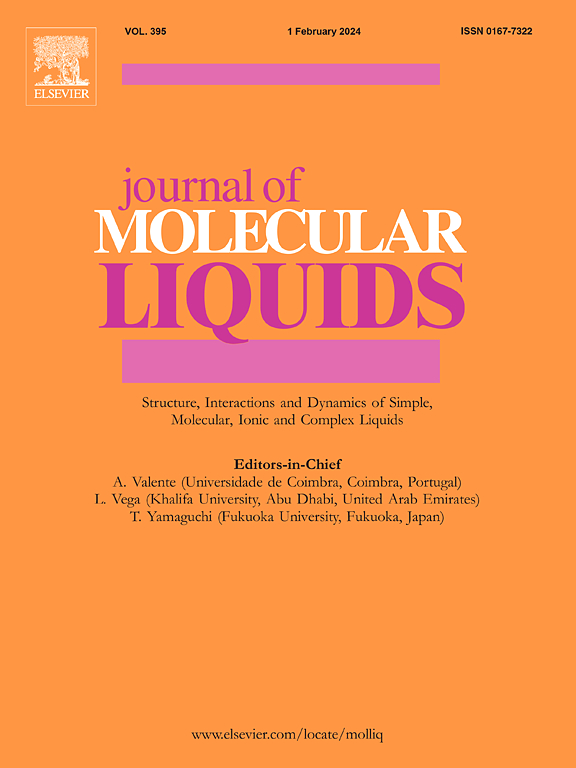Creating novel green synthesized cationic polymeric surfactants for removing the petroleum films from water surface: Surface-active and biological assessments
IF 5.3
2区 化学
Q2 CHEMISTRY, PHYSICAL
引用次数: 0
Abstract
The designation of new materials having multi applications and properties is the basic view of all researchers. Which a problem such as pollution of water surface from petroleum and diseases resulting from bacterial infection become very dangerous issues that have bad effect on environment. So, the series of cationic polymeric surfactants with desired applications as antimicrobial, petro-collecting and dispersing agents were developed. The series were derived from polymer with reactive phthalimide moiety undergoes exchange with derivatives of tertiary amines containing amino and hydroxyl groups. This is followed by quaternization the product of exchange reaction to afford the series of cationic amidated polymeric surfactants (CAPS) and cationic esterified polymeric surfactants (CEPS). The obtained materials were characterized by FT-IR and 1H NMR. The foam properties, emulsion stability and critical micelles concentration were reported for the synthesized cationic surfactants. Additionally, the petroleum capacities of collecting/ dispersing diluted and undiluted forms of synthesized polymeric surfactants were investigated in water of varying salinity. The activity of the synthesized surfactants as antimicrobial agents was reported against different species of bacteria. Also, these compounds were tested against Candida albicans ATCC 10231 (fungi). The results showed that all synthesized cationic surfactants showed a high efficiency towards all the tested microbes except compounds of CEPS towards Salmonella sp. But CAPS recorded the highest efficiency with the highest inhibition zone diameter (40 mm) than CEPS. Also, the data obtained revealed that compounds CAPS showed great efficiency against drug-resistant Staphylococcus aureus strains.

制备新型绿色合成阳离子聚合物表面活性剂,用于去除水面石油膜:表面活性和生物评价
具有多种用途和性能的新材料的命名是所有研究者的基本观点。石油对水体的污染、细菌感染引起的疾病等问题已成为危害环境的重大问题。因此,开发了具有抗菌、集油、分散等用途的阳离子高分子表面活性剂系列。该系列是由反应性邻苯二甲酸亚胺与含有氨基和羟基的叔胺衍生物交换而成的聚合物。然后对交换反应的产物进行季铵化,得到阳离子修饰型高分子表面活性剂(CAPS)和阳离子酯化型高分子表面活性剂(CEPS)系列。所得材料通过FT-IR和1H NMR进行了表征。报道了所合成的阳离子表面活性剂的泡沫性能、乳液稳定性和临界胶束浓度。此外,还研究了在不同盐度的水中收集/分散稀释和未稀释形式的合成聚合物表面活性剂的产油能力。报道了合成的表面活性剂对不同种类细菌的抑菌活性。此外,这些化合物对白色念珠菌ATCC 10231(真菌)进行了测试。结果表明,除cceps化合物外,其他阳离子表面活性剂对沙门氏菌均有较高的抑菌效率,但cceps的抑菌效果最好,抑菌带直径(40 mm)最大。此外,所获得的数据显示,化合物CAPS对耐药金黄色葡萄球菌菌株具有很高的效率。
本文章由计算机程序翻译,如有差异,请以英文原文为准。
求助全文
约1分钟内获得全文
求助全文
来源期刊

Journal of Molecular Liquids
化学-物理:原子、分子和化学物理
CiteScore
10.30
自引率
16.70%
发文量
2597
审稿时长
78 days
期刊介绍:
The journal includes papers in the following areas:
– Simple organic liquids and mixtures
– Ionic liquids
– Surfactant solutions (including micelles and vesicles) and liquid interfaces
– Colloidal solutions and nanoparticles
– Thermotropic and lyotropic liquid crystals
– Ferrofluids
– Water, aqueous solutions and other hydrogen-bonded liquids
– Lubricants, polymer solutions and melts
– Molten metals and salts
– Phase transitions and critical phenomena in liquids and confined fluids
– Self assembly in complex liquids.– Biomolecules in solution
The emphasis is on the molecular (or microscopic) understanding of particular liquids or liquid systems, especially concerning structure, dynamics and intermolecular forces. The experimental techniques used may include:
– Conventional spectroscopy (mid-IR and far-IR, Raman, NMR, etc.)
– Non-linear optics and time resolved spectroscopy (psec, fsec, asec, ISRS, etc.)
– Light scattering (Rayleigh, Brillouin, PCS, etc.)
– Dielectric relaxation
– X-ray and neutron scattering and diffraction.
Experimental studies, computer simulations (MD or MC) and analytical theory will be considered for publication; papers just reporting experimental results that do not contribute to the understanding of the fundamentals of molecular and ionic liquids will not be accepted. Only papers of a non-routine nature and advancing the field will be considered for publication.
 求助内容:
求助内容: 应助结果提醒方式:
应助结果提醒方式:


